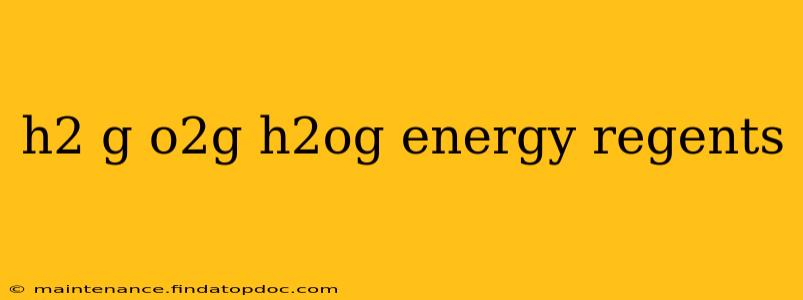Understanding the Energy Changes in H2, O2, and H2O: A Regents Prep Guide
The Regents exam often tests your understanding of energy changes in chemical reactions, particularly those involving simple molecules like hydrogen (H₂), oxygen (O₂), and water (H₂O). This guide will break down the key concepts and help you ace that section of the exam. We'll cover the energy involved in the formation and decomposition of these molecules, looking at both exothermic and endothermic processes.
What is the difference between exothermic and endothermic reactions?
This is a fundamental concept for understanding energy changes in chemical reactions. Exothermic reactions release energy to their surroundings, often in the form of heat. The products have lower potential energy than the reactants. Think of burning wood – it releases heat and light. Endothermic reactions, on the other hand, absorb energy from their surroundings. The products have higher potential energy than the reactants. Melting ice is a good example – it absorbs heat from its surroundings to change from solid to liquid.
Is the formation of water from hydrogen and oxygen exothermic or endothermic?
The formation of water (H₂O) from hydrogen gas (H₂) and oxygen gas (O₂) is a highly exothermic reaction. This means that a significant amount of energy is released as heat when hydrogen and oxygen combine to form water. This energy release is why hydrogen is considered a potential fuel source; its combustion with oxygen produces a substantial amount of energy. The balanced chemical equation is:
2H₂(g) + O₂(g) → 2H₂O(l) + Energy
The energy released is often represented as ΔH (change in enthalpy), which is negative for exothermic reactions.
How is the energy change in the formation of water related to bond energies?
The energy change in any chemical reaction is directly related to the bond energies of the reactants and products. In the formation of water, the energy released comes from the formation of strong O-H bonds in the water molecule. The energy required to break the H-H and O=O bonds in the reactants is less than the energy released when the O-H bonds form in the product. This difference in bond energies results in the net release of energy, confirming the exothermic nature of the reaction.
What is the energy change when water decomposes into hydrogen and oxygen?
The decomposition of water into hydrogen and oxygen is the reverse of its formation. Since the formation of water is exothermic, its decomposition is endothermic. This means energy must be supplied (usually as heat or electricity) to break the strong O-H bonds in water and separate it into hydrogen and oxygen gases. The balanced equation is:
2H₂O(l) + Energy → 2H₂(g) + O₂(g)
This endothermic process requires a significant input of energy.
What are some real-world applications of the energy changes in H2, O2, and H2O?
The energy released during the combustion of hydrogen is being explored as a potential source of clean energy. Electrolysis, the process of using electricity to decompose water into hydrogen and oxygen, is a method of producing hydrogen fuel. Understanding the energy changes involved in these processes is crucial for developing and optimizing these technologies. Furthermore, the exothermic nature of water formation is essential in various industrial processes and even in everyday occurrences like the burning of fuels.
How can I further study energy changes in chemical reactions for the Regents exam?
Review the concepts of enthalpy (ΔH), activation energy, and potential energy diagrams. Practice calculating energy changes using bond energies and enthalpy values. Work through practice problems and past Regents exams to solidify your understanding. Focusing on the relationship between the energy changes and the chemical equations will improve your ability to predict the type of reaction (exothermic or endothermic) and its implications. Remember to consult your textbook and class notes for further clarification and examples.
